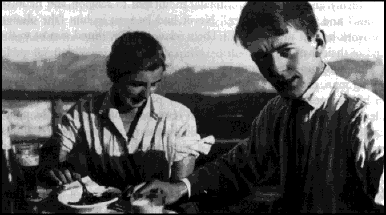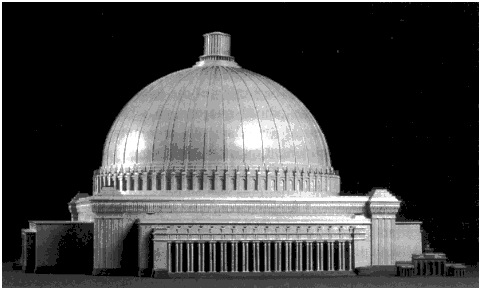Roy Jacobstein
(Wisconsin)
Indeed, he is equally at home eating knadlach, lamenting massacres in Tanzania, working admissions in the emergency room at a hospital, quoting from Proust (Never be afraid to go too far, for truth lies beyond), reciting memories of growing up in Detroit, viewing cheetahs in the Great Rift, or writing winningly about navels:
Lint collector, absominal eye, perpetual
seat of kindergarten curiosity ---
insie or outsie?---
you reign: universally mammalian, very
center of our being, mute remnant
of Mom long after Mom's
become remnant, invaginated marker
of life's arc. (Insie and outsie
inexorably recede.)
Put please tell us, Señor Umbilicus,
Miss B. Button, why you lack
those frissons of feeling
that got us here, you who should be
the ultimate pleasure zone ---
shapely, accessible,
clitoral, to whom reams of paeans
would certainly be penned ---
why you remain so
utterly unerogenous, ghost port
where all the great vessels
once docked.
What a pleasant surprise to run into Jacobstein, willing to speak from such a variety of experiences, as opposed to most of the Ivy League literary clones (or crones) who would think it beneath them to pen an ode to the omphaloskepsis.
Jacobstein not only does that, he writes a moving paean to a fellow doctor, dead at forty, because he volunteered as a relief doctor in Kuwait. The he gives us a moving tribute to the French poet Robert Desnos, in a boxcar destined for Dachau, reading palms, assuring the "woman with the gold tooth a long life... her twelve-year-old grandson clinging to her side, long life."
Then, in the next poem, "Reincarnation," he can imagine a mosquito "dive-bombing my ear" as Rasputin, this "newly hatched crop of anophelines, who unimpeded live/but a few days, and whose females alone bite, could be/Shakespeare."
I'll forbear from further attempts to squash what
well may be Mohandas K. Gandhi, secure in knowing
should I come back as a cat I'll sleep soundly, curled
upon myself on the soft couch while someone's
cousin or mother or child circles overhead
in her newfound brown body, shaking the last
of her human tears from her glistening wings.
I suspect it is this uncanny ability to mix many worlds into verse that makes his writings in no way pretentious, icy or inhumane, an honest blend of love and humor and despair and surprise and weariness --- all melded into a grave wonder.
For this reader, Jacobstein's art reaches an apex when he is able to join the wisdom of his trade to the tragedy of what the body can give, with its infinite ability to surprise, dumbfound, and destroy. In a page out of his youth, it's (an old lover) asking a question ("do you think much about death?") for he is ill ("a rare growth.") The poet invokes the many tools in his subtle craft: repetition ("February and February"), symbolism ("a closet door," "the sallow full moon"), run-on lines ("do you think much/about death except yes?") linear puns ("other-/wise silent") and the final end-stop ambivalent paradox ("What you want to say is no.")
It's a mastery which manages to be deceptively simple:
What do you say to your long-
time friend and former lover
who asks you do you think much
about death except yes?
She asks because a rare
growth is choking her sacrum.
She tells you she is standing
before a closed door. She means they are staging her next play
next February and February
is six months away. Her face
shows the sallow full moon
of palliation. You sit other-
wise silent on the back deck.
What you want to say is no.
Remembering Barns
Morley Baer
(Stanford)

And you are swept up with a feeling of life slipping inexorably by, the days turning weathered, the promise of those days back then when you were free and alive out there in the fields, you filled with the promise of your days, your very soul packed with the power of the years awaiting you, the world and its problems diminished by the size of the flatland --- and so you contemplate this graceful edifice from so long ago, reminding you of the one-time passion for order and space that drove you so powerfully back then, with this sole sentinel standing powerfully alone at the edge of your days, a solemn structure, beaten and pushed by time, reminding you of you and your hopes of other hot, windy days, when the fields were rich, the riffles of the breezes bending the crowns of the fields in repeating waves, the barn filled with life and the sounds of animals and men working and the smells of hay and manure and sweat and feed, the feel of the eternal hope of these years stretched like the shadows not yet stolen safely past all bearing, the hope of all who grew with the promise of this land, those who tilled in honor and simplicity and sturdy faith, the simple land and hope of our fathers represented by this single falling artifact of our past.
Something impelled Morley Baer to capture these soulful images from 1951 to 1994, riding the backwoods, with his equipment, coming over the hill, seeing the structure, driving about it, waiting (sometimes waiting hours) for a single exposure, to capture it at its most lonely and lovely best.
Whenever I wanted to make a photograph, he would decide whether my choice of material was important enough to stop the car. This was beginning to wear on our relationship, so in a very nice way I announced a new set of rules.
Every possible vista on the left side of the car belonged to the driver, all on the right was the passenger. When one of them wanted to stop, no questions permitted.
One spring day Morley and I were driving south towards Oceano. I was the passenger. When I spotted a handsome red barn, I raised my hand and said, "Stop!" Morley was surprised and looked around. "You can't make a photograph of that barn," he said. "I'm the architectural photographer!" To this I very firmly replied, "Morley, you know the rules. The barn is on the right-hand side of the road. I saw it, and I'm going to make a photograph of it."
Collecting my equipment, I set forth across the sand. No sooner was I under the darkcloth than I could hear Morley huffing and puffing behind me. As I finished the exposure, he passed me --- camera over his shoulder --- running hard. "If you photograph my barn, Morley Baer, I am going to divorce you this very night!"
Even with that threat, I knew in my heart he was a brilliant photographer. I knew he would look at the barn and look at his light and know exactly what his photograph would be without ever looking into his camera. I also knew he would know just what mine was going to look like.
We didn't ever get the divorce; and as for Morley's Barn Door, Jalama Beach, well, that speaks for itself.
The Final
Verdict
Joachim Fest
(Harcourt)

In these pageants, Speer created a drama of simple lines: huge banners, vast crowds filling a vast space, Der Führer alone, striding towards the Heroes' Memorial, accompanied by funereal music. The world had never seen such a marriage of pageant and scale and order.
The Reich Party Rallies ... produced what was probably Speer's most ingenious and perhaps his only lasting idea. In order to spare the audience the sight of the unprepossessing office-holders, who had grown corpulent in their new jobs, he had suggested to Hitler that as many of the events as possible be moved to the evening or the night. This enabled him to use the light beams that had proved so effective at Tempelhof on a far larger scale. An official report records how, after Hitler's arrival toward eight o'clock, "the darkness was suddenly lit in a flood of white" by columns of light surging from 150 projectors posted all around at intervals of some forty feet. In the night sky shrouded black-grey," their vertical beams met under the cloud cover "to form a blazing square crown." Simultaneously, the main tribune was "plunged into blinding brightness." On the lateral pillars "flames licked up from large dishes," while from all sides "over thirty thousand banners" streamed into the arena, "their silver points and tassels flashing in the light."
These famous domes of light, rising as they did miles into the sky, made Speer one of the "fathers of light architecture." Sometimes, he recalled, a cloud would pass at a great height through the cone of the beams, transporting those present into an almost other-worldly state, as if carried by magic to one of the "crystal fantasy castles of the Middle Ages" or into "a Gothic Cathedral."
From the end of WWI, orderly Germans had fumed over the disorder of the democratic Weimar Republic. The streets had been a battleground for the Nazis, the Communists and a dozen other splinter groups. Then came the collapse of the mark, and the worldwide depression. Families watched their savings destroyed in the hyperinflation of 1923 and their jobs evaporate in the depression. They were ready for a regime of order. Once elected to office, the Nazis gave it to them --- in spades, beginning with the rallies.
The fascination here is one of beauty and the beast --- cool, patrician Speer alongside a creepy psychopath who, with hypnotising speeches (combined with the new invention called radio) convinced an entire country that his strange view of history and evil was the truth. And the people bought into his schizophrenia; indeed, one might surmise that the whole of Germany from 1933 to 1945 was a state lunatic asylum. Hitler's madness --- and the cruelty born to that madness --- became the norm while normal elements of kindness and humanity were viciously expunged. The land of Bach, Mozart, Hegel, Beethoven, Goethe, Schubert, Schiller, Freud, and Einstein was subsumed to a neo-romantic monstrosity.
Albert Speer was elegant, well spoken, low key, a non-stop perfectionist --- one of the few of Hitler's fellow-travelers who was not a pure troglodyte. Fest claims that there was love between the two of them:
Various critics have detected 'traces of an erotic motif' in the relationship between Hitler and Speer, with architecture providing the common ground for discussion and agreement. Indeed, the strange friendship very soon transcended professional amity. It developed into an attachment of a kind unfamiliar to both men and beset with many inhibitions ... It endured right up to the very last hours, when Speer returned to Berlin engulfed by flames to say good-bye to the man who, he believed, had put the world at his feet and then destroyed it.
In his early years, Hitler would address crowds, "which he was fond of equating with 'the female,' more than a dozen times a day:"
The first storms of applause roused him from his trance, lifting him higher and higher, up to passages that seemed to flow as though he was liberated; he then accelerated, urged, and drew things out...until finally, shaking and his voice breaking, he reached the spasms of his concluding phrases.
One observer said that when he descended from the podium, his pants were always soaking wet.

At Nuremberg, it was fully expected that Speer would be put to death. At his trial, he claimed that he scarcely knew of the Nazi extermination program; that in the last six months of the war he had defied Hitler's orders to raze all German cities before they were captured by the Allies.It was a clever defense. He was saying, "I am guilty of being part of a monstrous political movement. I did not know the full extent of it, but I am still guilty. I also want you to know the good I did for post-war Europe." That extraordinary defense saved him from being hanged.
Speer lived on for another 35 years. Twenty were spent at Spandau Prison, where he smuggled out notes that were later to be published as Inside the Third Reich. He died in England, in 1981, in the arms of a young lady who had fallen in love with his Spandau Diaries --- his first passion, possibly, after Adolf Hitler.
§ § § So what are we to make of it all? The Final Verdict is an impressive work, well-written, solidly researched, to-the-
point biography. It presents us with a rarity: an intimate of Hitler who could tell us what he was like with coolness, and with the icy distance of time. We learn of the way Hitler dealt with his subordinates; we learn of his magic "before the masses" and on those who were his close followers; we learn of the evenings where he held forth for hours and hours for his increasingly drowsy guests, repeating tedious tales of the early Glory Days of the Party. We learn of his endless plans made with Speer to rebuild the cities of Germany --- especially Berlin --- with huge, ugly temples to honor the fallen --- complete with broad avenues and monstrous domes. Indeed, one of the last photographs we have is Hitler hunched over the room-sized model of "World Capital Germania" --- the one that Speer had built especially for him. Speer rather boldly called his architectural ideas the "Doric style." Fest refers to it as "Despotic Architecture."
It was a hodgepodge of bulky historical forms that originated not so much in ancient Greece as in Egypt, Assur, or Nineveh. While he may have dreamed of becoming Schinkel's successor, he got much nearer to Cecil B. DeMille.
--- Randy Block, M.A.